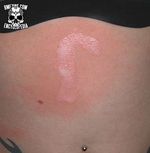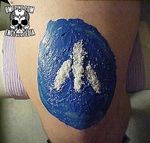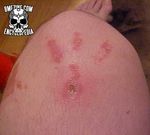Chemical scarification: Difference between revisions
(Created page with "<html><div class="mw-content-ltr" dir="ltr" id="mw-content-text" lang="en"><div class="thumb tright"><div class="thumbinner" style="width:152px;"><a class="image" href="/index.php?title=File:Chemical_Scarification-1.jpg"><img alt="" class="thumbimage" height="153" src="/images/thumb/3/38/Chemical_Scarification-1.jpg/150px-Chemical_Scarification-1.jpg" width="150"/></a> <div class="thumbcaption"><div class="magnify"><a class="internal" href="/index.php?title=File:Chemical...") |
(Page conversion via llm-mediawiki-rev -jwm) |
||
| Line 1: | Line 1: | ||
[[File:Chemical_Scarification-1.jpg|150px|right|thumb|Chemical Scarification]] | |||
[[File:Chemical_Scarification-2.jpg|150px|right|thumb|Chemical Scarification]] | |||
[[File:Chemical_Scarification-3.jpg|150px|right|thumb|Chemical Scarification]] | |||
'''Chemical scarification''' is simply that, [[Scarification]] using a chemical reaction as the means of either further irritating a wound achieved by another means (i.e. [[Cutting]]) or directly producing the wound. | |||
</ | == Contents == | ||
* 1 [[#Method|Method]] | |||
* 2 [[#Chemicals|Chemicals]] | |||
* 3 [[#Considerations|Considerations]] | |||
== Method == | |||
In the first case, the design of the [[Scar]] is cut into the flesh using a [[Scalpel]]. Then, a chemical irritant is added to the cut to ensure heavy, [[Keloid|raised scarring]]. This irritant can be anything from soap to formaldehyde. | |||
In the second case, a chemical is used exclusively to achieve the scarred pattern. | |||
The method for this is usually as follows: | |||
# The area to be scarred is shaved, washed, and prepared. | |||
# The pattern is blocked out on the skin in negative using some water-proof and chemical-resistant material. This can be Saran Wrap, Vaseline, or tape (with heavy-duty tape being, arguably, the best choice). | |||
# The chemical is added to the negative space in the blocking, creating a positive of the pattern on the skin. | |||
# During a period of 2 to 10 minutes, the chemical does its work. This is the time when the most [[Pain]] is experienced. | |||
# The chemical is either rinsed off with large amounts of water, or is neutralized chemically. | |||
== Chemicals == | |||
While many chemicals are caustic enough to cause scarring, the choice of chemical used is extremely important. While they may seem like obvious choices, acids — eg. HCl<sub>(aq)</sub> (Hydrochloric acid), H<sub>2</sub>SO<sub>4</sub> (Sulfuric acid) — and bases — NaOH (Sodium hydroxide, lye, caustic soda; the chemical used in the movie ''Fight Club''), KOH (Potassium hydroxide) — should '''never''' be used for chemical scarification. In order for a acid or a base to work, it must be completely dissolved in water. In such a liquid form, it is nearly impossible to control the placement and spread of the chemical. | |||
Another downside of using strong acids and bases for chemical scarification is that at concentrations sufficient to cause the level of burn needed to scar, these chemicals work incredibly quickly: on the order of a few seconds. While this may seem desirable (pain of shorter duration), it means that if the chemical is not removed in a timely fashion, it can easily burn far more deeply than is desired. | |||
To make matters worse, to safely remove the chemical from the area, it must be neutralized. This is a difficult thing to accomplish precisely even in a test tube, let alone on someone's body. If water is used to rinse away an un-neutralized strongly acidic or basic solution, the result is likely to be massive chemical burning over large parts of the body as the water simply dilutes and spreads the chemical. (To add insult to injury, many of acids and bases are toxic besides being caustic.) | |||
A better choice is some oxidizing agent. While they still require some water to activate the reaction, most oxidizing agents do not need to be fully dissolved to work. As such, they can be kept mostly dry, making them significantly easier to control. Also, because they work far more slowly than acids and bases, they can be effectively removed with large quantities of water with lower risk of burns to the rest of the body. Chlorine-based oxidizers, such as those used to disinfect swimming pools, should never be used due to their toxicity. A good choice is AgNO<sub>3</sub>, which is a non-toxic oxidizer routinely used as a disinfectant in newborns. | |||
== Considerations == | |||
While there have been successes with chemical scarification, it is not a modification to be taken lightly. It requires not only an understanding of physiology as it relates to body modification, but also of chemistry. Furthermore, it is not nearly as precise as other forms of scarification, since the pattern, by necessity, must be simple enough to block out on the body in some material. | |||
It is one of the most painful forms of modification possible, as the slowly rising pain of the chemical starting to react must be endured. And because there is no rapid destruction of nerve ends (as in [[Branding]]), every moment of pain is felt to its fullest degree. | |||
It almost goes without saying that if you do not understand ''every'' chemical term, concept, and formula in the above description, you '''should NOT''' attempt chemical scarification. Come to think of it, even if you do understand the theory, you probably shouldn't attempt it; it is simply too complex and provides too many sources of error to be a routinely effective means of scarification — stick to branding and cutting instead. | |||
Latest revision as of 01:27, 17 September 2023
Chemical scarification is simply that, Scarification using a chemical reaction as the means of either further irritating a wound achieved by another means (i.e. Cutting) or directly producing the wound.
Contents
- 1 Method
- 2 Chemicals
- 3 Considerations
Method
In the first case, the design of the Scar is cut into the flesh using a Scalpel. Then, a chemical irritant is added to the cut to ensure heavy, raised scarring. This irritant can be anything from soap to formaldehyde.
In the second case, a chemical is used exclusively to achieve the scarred pattern.
The method for this is usually as follows:
- The area to be scarred is shaved, washed, and prepared.
- The pattern is blocked out on the skin in negative using some water-proof and chemical-resistant material. This can be Saran Wrap, Vaseline, or tape (with heavy-duty tape being, arguably, the best choice).
- The chemical is added to the negative space in the blocking, creating a positive of the pattern on the skin.
- During a period of 2 to 10 minutes, the chemical does its work. This is the time when the most Pain is experienced.
- The chemical is either rinsed off with large amounts of water, or is neutralized chemically.
Chemicals
While many chemicals are caustic enough to cause scarring, the choice of chemical used is extremely important. While they may seem like obvious choices, acids — eg. HCl(aq) (Hydrochloric acid), H2SO4 (Sulfuric acid) — and bases — NaOH (Sodium hydroxide, lye, caustic soda; the chemical used in the movie Fight Club), KOH (Potassium hydroxide) — should never be used for chemical scarification. In order for a acid or a base to work, it must be completely dissolved in water. In such a liquid form, it is nearly impossible to control the placement and spread of the chemical.
Another downside of using strong acids and bases for chemical scarification is that at concentrations sufficient to cause the level of burn needed to scar, these chemicals work incredibly quickly: on the order of a few seconds. While this may seem desirable (pain of shorter duration), it means that if the chemical is not removed in a timely fashion, it can easily burn far more deeply than is desired.
To make matters worse, to safely remove the chemical from the area, it must be neutralized. This is a difficult thing to accomplish precisely even in a test tube, let alone on someone's body. If water is used to rinse away an un-neutralized strongly acidic or basic solution, the result is likely to be massive chemical burning over large parts of the body as the water simply dilutes and spreads the chemical. (To add insult to injury, many of acids and bases are toxic besides being caustic.)
A better choice is some oxidizing agent. While they still require some water to activate the reaction, most oxidizing agents do not need to be fully dissolved to work. As such, they can be kept mostly dry, making them significantly easier to control. Also, because they work far more slowly than acids and bases, they can be effectively removed with large quantities of water with lower risk of burns to the rest of the body. Chlorine-based oxidizers, such as those used to disinfect swimming pools, should never be used due to their toxicity. A good choice is AgNO3, which is a non-toxic oxidizer routinely used as a disinfectant in newborns.
Considerations
While there have been successes with chemical scarification, it is not a modification to be taken lightly. It requires not only an understanding of physiology as it relates to body modification, but also of chemistry. Furthermore, it is not nearly as precise as other forms of scarification, since the pattern, by necessity, must be simple enough to block out on the body in some material.
It is one of the most painful forms of modification possible, as the slowly rising pain of the chemical starting to react must be endured. And because there is no rapid destruction of nerve ends (as in Branding), every moment of pain is felt to its fullest degree.
It almost goes without saying that if you do not understand every chemical term, concept, and formula in the above description, you should NOT attempt chemical scarification. Come to think of it, even if you do understand the theory, you probably shouldn't attempt it; it is simply too complex and provides too many sources of error to be a routinely effective means of scarification — stick to branding and cutting instead.


